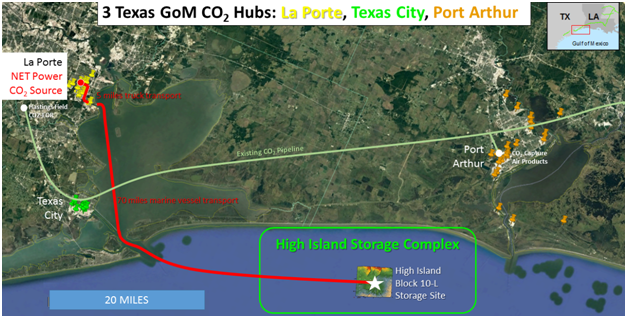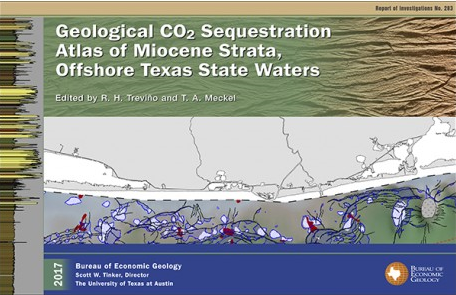CarbonSAFE Phase II: Storage Complex Feasibility - Northwest Gulf of Mexico
Read more here about Phase I of this project and its accomplishments.
Three energy hubs in southeast Texas and a proposal to make a first-of-its-kind integrated carbon capture and storage (CCS) chain
The nation's largest significant storage resource is the Miocene stratigraphy of the northwest inner Gulf of Mexico shelf region which is co-located with 45 diverse large-volume industrial sources of CO2 of the Houston-Port Arthur industrial corridor, which together create an ideal opportunity for developing the nation’s first CO2 hub.
The objective of this project proposal is to mature and advance one high-potential, commercial-scale CO2 geological storage site and link it to a capture site in order to integrate a full capture, transport, and storage chain within the highest-emitting region of the state with the highest U.S. emissions. This first-of-its-kind high-volume, low-risk storage model has the potential to propagate throughout the Gulf Coast, U.S. waters, becoming widespread globally.
- Nation's largest CO2 storage resource off the coast of Texas: P50 static capacity of 30.1 Gt CO2 within a 172 GT regional trend
- The storage complex region in the High Island Area of Texas state waters has the potential to store 50+ million metric tons of CO2 safely, permanently and economically.
U.S. state with the highest emissions and a region of interest for integrated hubs
Texas is the largest user of coal in the U.S. and hosts the largest industrial petrochemical processing facilities, resulting in the nation’s largest CO2 emissions by state. Three primary energy hubs in southeast Texas (La Porte, Texas City, and Beaumont-Port Arthur) currently emit a significant proportion of the state's total. Dozens of diverse facilities in these three hubs account for a large portion, indicating significant future aggregation opportunities that provide economies of scale. The region of interest is currently undergoing globally-significant industrial expansion and investment, as a result of abundant unconventional natural gas in the region. Opportunities to integrate CO2 management are diverse and volumetrically significant.

The planned project area in southeast Texas (regional inset map, upper right), is an evolving CCS hub with existing infrastructure including northwest Gulf of Mexico near-offshore storage potential.
Adjacent significant offshore storage potential
Offshore stratigraphy accounts for more than one-third of the identified U.S. storage resources (NETL, 2015). In order to move this resource in the Gulf of Mexico region from prospective storage resources to contingent storage resources, and ultimately through prospects, leads, and plays to capacity1 (proved, probable, and possible) that is ready for permitting is essential to progress commercial development in the U.S.
Project targets to develop first
The CO2 source for the proposed project would be NET Power in La Porte. Gigaton-scale storage capacity in the near-offshore is supported with extensive 3-D seismic and well data, but needs to be demonstrated. High Island Block 10-L has been identified for the CO2 storage site, with CO2 transport via truck and marine vessel. The proposed Phase 2 feasibility project will further develop this offshore CCS storage complex to be sited and permitted for transport and injection to match the available CO2 supply at NET Power, demonstrating zero-emissions electricity generation.
Read more here about the justification and down-selection of the source, transport, and storage options.
The expected outcomes of this project
The CarbonSAFE Phase II project will build upon substantive prior investments in the storage potential of the region in Phase I. This Phase II will develop a detailed front-end engineering site development plan and permitting, establish a CO2 management strategy, conduct optimized and targeted risk assessment, engage stakeholders with outreach, evaluate regulatory pathways, and advance a site development plan with financial plans to further development.
[1] The Society of Petroleum Engineers defines prospective storage resources, contingent storage resources, and capacity in the CO2 Storage Resources Management System document, similar to the Petroleum Resources Classification System.



